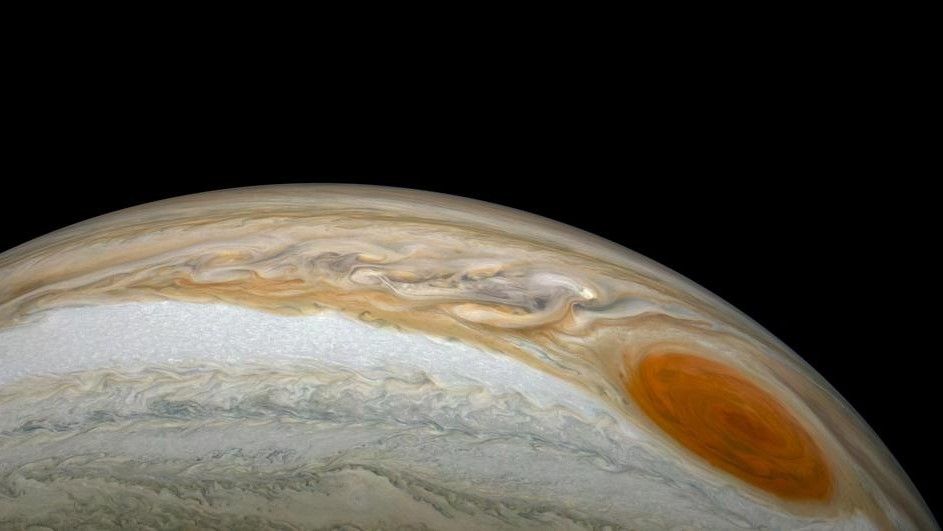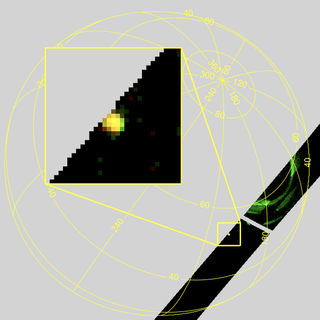Meteor streaks through Jupiter's atmosphere as NASA spacecraft watches

When a rogue meteor careened through the atmosphere of Jupiter last year, it caught the attention of NASA's Juno spacecraft in orbit around the giant planet.
The brief and sudden flash in Jupiter's upper atmosphere was spotted by NASA's Juno spacecraft in April 2020. But, while the burst of light didn't last long, it drew scientists' attention as its spectral characteristics didn't line up with what would be expected in Jupiter's aurora, the Juno mission team announced this month.
So what caused the Jovian disruption? Scientists think it was a meteor.
Related: Jupiter hit by another space rock in rare views by Japanese skywatchers

The event was observed by Juno's ultraviolet spectrograph (UVS), an instrument that studies ultraviolet light, specifically honing in on Jupiter's aurora and looking for gasses like hydrogen in its observations. In investigating flash, researchers think that both the length of the light burst and the spectrum UVS observed line up with the event being the result of a meteor in the planet's atmosphere, according to a Juno mission update on March 1.
The mission team estimates that the meteor hurtling through Jupiter's upper atmosphere was likely between about 550 and 11,000 pounds (250-5,000 kilograms).
But this isn't the first time that researchers have spotted space rocks in the Jovian atmosphere. In fact, in September and October of 2021, two different asteroids were spotted whizzing toward the planet just a month apart.
Get the Space.com Newsletter
Breaking space news, the latest updates on rocket launches, skywatching events and more!
While closer observations by instruments like UVS can give scientists more information and allow them to confirm a sighting like this, Jovian fireballs can be spotted by small telescopes from the ground on Earth. In 2021, skywatchers in Japan were able to photograph a flash in Jupiter's atmosphere, observations that were later confirmed to be a meteor by a research team.
"These fireballs are very rare, they are very difficult to be observed just by chance," Ricardo Hueso, an astronomer at the University of the Basque Country in Spain who has studied these sightings, told Space.com in 2021 about the two space rock sightings. "This year has been exceptional because normally we discover one of these impacts every two years approximately."
While it is unlikely to see such frequent meteor flybys at Jupiter, the planet's powerful gravitational pull makes it a likely target for meteor impacts. Jupiter's immense size has made it the planet with the most gravity in the entire solar system and its gravitational tug easily pulls small objects like asteroids into its atmosphere.
NASA's Juno spacecraft, which entered Jupiter's orbit in 2016, continues to monitor the planet, studying the gas giant in detail. The probe continues to reveal new insights into the planet's atmosphere, weather, evolution and formation history and more.
But Juno is not the first spacecraft to get an up-close view of meteors in Jupiter's atmosphere. It is the second long-term mission at Jupiter, following NASA's Galileo spacecraft which circled the planet from 1995 to 2003. Galileo and NASA's Voyager spacecraft, which launched in the 1970s and decades later reached interstellar space, have both spotted meteors in Jupiter's atmosphere during their missions.
"Each new observation helps to constrain the overall impact rate, an important element to understanding the planet’s composition," the Juno mission team wrote in the update.
Email Chelsea Gohd at cgohd@space.com or follow her on Twitter @chelsea_gohd. Follow us on Twitter @Spacedotcom and on Facebook.
Join our Space Forums to keep talking space on the latest missions, night sky and more! And if you have a news tip, correction or comment, let us know at: community@space.com.

Chelsea “Foxanne” Gohd joined Space.com in 2018 and is now a Senior Writer, writing about everything from climate change to planetary science and human spaceflight in both articles and on-camera in videos. With a degree in Public Health and biological sciences, Chelsea has written and worked for institutions including the American Museum of Natural History, Scientific American, Discover Magazine Blog, Astronomy Magazine and Live Science. When not writing, editing or filming something space-y, Chelsea "Foxanne" Gohd is writing music and performing as Foxanne, even launching a song to space in 2021 with Inspiration4. You can follow her on Twitter @chelsea_gohd and @foxannemusic.












